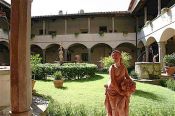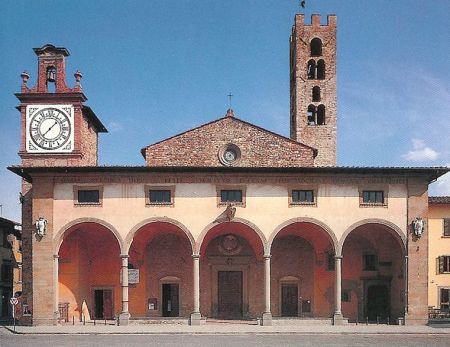The Basilica of Santa Maria at Impruneta

History of the Church of Santa Maria
Initially, a shrine was located where the present church stands, and this shrine was consecrated in 1060 by the Cardinal Umberto di Selva Candida. In the 14 C, the church was enlarged. Afterwards, in the 15 C, Bishop Antonio degli Agli undertook additional restoration. He was a famous humanist and was the parish priest from 1439 to 1477, when he died. During this period he had a wall built around the building, with towers at the corners to make the church appear to be an impregnable fortress. Inside, two small temples were built, based on the one designed by Michelozzo in the Santissima Annunziata church in Florence. In 1634, the company of the stigmata of San Francis built, at its own expense, the arcade on the front facade of the church. It was designed by the architect Gherardo Silvani.After the 1944 bombing, which destroyed the baroque ceiling, the church was restored in Renaissance style.
The sacred image of the Virgin
The fame and the success of the shrine are based on the cult of the image of the Virgin, which the tradition ascribes to Saint Luke the Evangelist. According to this legend, at the time of the arrival of Christianity, the image was taken to Florence by Saint Romolo and his followers. Due to the persecutions, they hid the image by burying it "in pruinetis", "among the pines", from which the name Impruneta is said to derive.A famous procession to Florence started in the Basilica. The Bishop Casotti makes a reference to the excitement and the joy of the entire population of Impruneta: “At night in the village, those people, extremely devoted to their protectress, started to light fires and lights and through cracker shots they signalled that the day of the procession was close. That was enough for everyone to compete and show his devotion in the two nights following, Friday and Saturday, lighting fires all over the hills for ten miles around.” The author describes the participation of the Companies in the procession “so that the people coming to the procession were about 800. After them the Company of the Pieve followed, which numbered 400 people. And almost all the men of these confraternities carried a torch or some other kind lights in their hands.”

The architecture and decoration of Church
The church has a high battlemented bell-tower built in the XIII century, with four alternating orders of single and double lancet windows. The arcade of the facade, designed by Gherardo Silvani (1634), is composed of five wide arches surmounted by rectangular windows. On the left of the facade, there is a Mediaeval civic tower, with a large clock face. The stone commorating the first consecration is located under the arcade of the facade.The interior has one wide nave in Renaissance style: the arches are made of pietra serena and they act as a frame for the altars. The apse is deep. The trusses of the ceiling stand out. At both of the entrances, there are two small holy water basins (1542 and 1637).
As one enters, the altar of the “Martyrdom of Saint Lawrence” by Cristofano Allori is on the right. Following there is the painting of the “Nativity of the Virgin” by Domenico Crespi known as il Passignano. On the left, after having passed the baptistery, in which there is a baptismal font made in 1590, one sees two paintings: “The vocation of Peter and Andrew” (1606) by Jacopo Chimenti (known as Jacopo da Empoli) and “The martyrdom of Saint Sebastian” by Matteo Rosselli.
Two small temples dedicated to the Virgin and to Christ precede the presbytery. Both the temples were seriously damaged in the 1944 bombing and later they were reassembled using all the fragments that could be found. Now they are protected by a marble precinct made of four fluted columns with Corinthian capitals. Above there is a rich trabeation. The ceiling is adorned with majolica lacunars.
The aedicule on the right is the Chapel of the Cross, whose altar-piece, “The crucifix among the Virgin, Saint John and Angels”, was made by Luca della Robbia (glazed terracotta on an azure background). The side statues of Saint John the Baptist and Augustine are also by della Robbia, as well as the altar step with Flying angels on the sides of the tabernacle and the polychrome majolica ceiling.
The aedicule on the left is called the Chapel of the Virgin and is decorated with beautiful works by Luca della Robbia, including the polychrome majolica frieze of the architrave with leaves and fruit, two small bas-reliefs with the Virgin and Child, the decoration on the ceiling and the majolica statues of Saint Paul and Luke which are at both sides of the tabernacle. In this chapel, is the famous sacred image of the Virgin with Child in which traces of the XIII-century painting are still visible. This painting is displayed only on special occasions. It has been ascribed to Luke the Evangelist, but it was repainted by the English painter Enrico Hugford in 1758 on a support which probably dates back to the XIII century.
The steps above the Lord’s Table in the altar are decorated with embossed silver medallions and semiprecious stones. The silver ciborium, which is heavily decorated, depicts “The finding of the Sacred Image”. The frontal, presented by Cosimo III as an ex voto, depicts the Grand Duke praying in front of the image of the Virgin.
On the main altar, we find the great polypytch with Virgin with Child and Florentine Saints Tommaso del Mazza e Pietro Nelli (1375), reassembled after the severe damage caused by the war.
On the right, a chapel houses the tomb of the Bishop Antonio degli Agli (XV century) surmounted by a medallion with a Virgin with child by the workshop of Antonio da Maiano.
The rich XVIII-century choir has been put in its original place within the interior facade. This is the location where once the XVI-century organ was placed.
Many rare and beautiful items from the church are displayed in the treasury.
Click here for a guide to the Church Treasure.
Click here for a guide to the Church Treasure.

